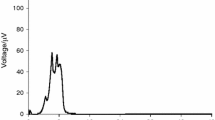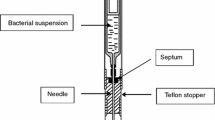Abstract
The biological effect of Se and Cu2+ on Escherichia coli (E. coli) growth was studied by using a 3114/3236 TAM Air Isothermal Calorimeter, ampoule method, at 37°C. From the thermogenesis curves, the thermokinetic equations were established under different conditions. The kinetics showed that a low concentration of Se (1–10 μg/mL) promoted the growth of E. coli, and a high concentration of Se (>10 μg/mL) inhibited the growth, but the Cu2+ was always inhibiting the growth of E. coli. Moreover, there was an antagonistic or positive synergistic effect of Se and Cu2+ on E. coli in the different culture medium when Se was 1–10 μg/ml and Cu2+ was 1–20 μg/ml. There was a negative synergistic effect of Se and Cu2+ on E. coli when Se was higher than 10 μg/ml and Cu2+ was higher than 20 μg/ml. The antagonistic or synergistic effect between Se and Cu2+ on E. coli was related to the formation of Cu–Se complexes under the different experimental conditions chosen.



Similar content being viewed by others
References
Mohammad AH, Bahram F, Jesus T, Norma L, Rodriguez RC (2009) Maternal milk concentration of zinc, iron, selenium, and iodine and its relationship to dietary intakes. Biol Trace Elem Res 127:6–15
Dervis O, Hafize U (2009) Copper intoxication; antioxidant defenses and oxidative damage in rat brain. Biol Trace Elem Res 127:45–52
Zhang L, Wan N (2006) Advances in the research of sport fatigue caused by the action of free radical lipid oxidation. Chinese J Laboratory Diagn 10(9):1104–11081
Liu Z-D (1990) Genetics. Higher Education Press, Beijing, pp 365–372
Bjerregaard P, Andersen BW, Rankin JC (1999) Retention of methyl mercury and inorganic mercury in rainbow trout Oncorhynchus mykiss (W): effect of dietary selenium. Aquat Toxicol 45:171–180
Qian Z, Sun J, Tie B-Q, Mao X-Q, Zhan L-Z (2006) The toxic effect of Cu, Cd, As and their compound pollution on the duckweed. Chinese J Eco Agric 14(3):135–137
Wang K (1996) Trace element in life science. Chinese Measure, Beijing, 523
Liu P, Wang Q-S, Li X (2009) Studies on CdSe/l-cysteine quantum dots synthesized in aqueous solution for biological labeling. J Phys Chem C 113:7670–7676
Narayan P, X-G P (2007) Efficient and color-tunable Mn-doped ZnSe nanocrystal emitters: control of optical performance via greener synthetic chemistry. J Am Chem Soc 129:3339–3347
Narayan P, David G, Jason T, X-G P (2005) An alternative of CdSe nanocrystal emitters: pure and tunable impurity emissions in ZnSe nanocrystals. J Am Chem Soc 127:17586–17587
Igor LM, Tetsuo UH, Goldman ER, Mattoussi H et al (2005) Quantum dot bioconjugates for imaging, labelling and sensing. Nature Materials 4:435–446
Nathan IH, Todd E, Michael DB (2007) Quantum dots coordinated with conjugated organic ligands: new nanomaterials with novel photophysics. Nanoscale Res Lett 2:282–290
Akiyoshi H, Kouki F, Taisuke O, Shun N, Masakazu S (2004) Quantum dots targeted to the assigned organelle in living cells. Microbiol Immunol 48(2):985–994
Xu X-J, Xue Z, Xiao Q, Hou A-X, Liu Y (2008) Antibacterial activities of novel diselenide-bridged bis (porphyrin)s on Staphylococcus aureus investigated by microcalorimetry. Biol Trace Elem Res 125(2):185–192
Li X, Liu Y, Deng F-J, Wang C-X, Qu S-S (2000) Microcalorimetric study of the toxic effect of sodium selenite on the mitochondria metabolism of Carassius auratus liver. Biol Trace Elem Res 77:261–271
Li X, Liu Y, Zhao R-M, Wu J, Shen X-S, Qu S-S (2000) Microcalorimetric study of E. coli growth inhibited by the selenomorpholine complexes. Biol Trace Elem Res 75(1-3):167–175
Buikema AL Jr, Niederlehner BR, Cairns J Jr (1982) Biological monitoring. Part IV. Toxicity testing. Water Res 16(3):239–262
Buckion G, Russell SJ, Beezer AE (1991) Pharmaceutical calorimetry: A selective review. Thermochim Acta 193:195–214
Chen X-J, Shen Y-F, Feng W-S, Liu Y, Miao W (2006) Advances on Isothermal microcalorimetric studies of microbial communities. Chemistry in Chinese 69:1–8
Liu P, Liu Y, Chen Y-G, Qu S-S (2002) The Study of isothermal microcalorimetry method and its application in life science. Chin J Chem (10):682–687
Liu Y (1997) Thermochemical Studies of Metabolic Characteristics of Bacteria and Mitochondria. [Ph.D.Thesis], Wuhan University, Wuhan, the People’s Republic of China
Bayse CA, Allison BD (2007) Activation energies of selenoxide elimination from Se-substituted selenocysteine. J Mol Model 13:47–53
Cui Q-H, Tang J-C, Huang Y-G (2002) Effects of lead and selenium on telomere binding protein Rap1p, telomerase and telomeric DNA in Saccharomyces cerevisiae. Acta Biochimica Et Biophysica Sinica 34(2):240–244
Liu Q, Wang H, Hu D-C, Ding C-J, Xiao H et al (2003) Effects of sodium selenite on telomerase activity and telomere length. Acta Biochimica Et Biophysica Sinica 35(12):1117–1122
Li X, Liu Y, Wu J, Qu S-S (2003) Microcalorimetric study of the associated action of Se4+ to arsenic on the growth of E. coli. Chem J Chin Univ 24(1):91–94
Fu Y-H (1997) Trace element and clinic. Chinese Medicine Science and Technology, Beijing
Jensen LS (1975) Proc Soc Exp Biol Med 149:113
Wadso I (1997) Chem Soc Rev:79–86
Acknowledgments
This study was supported by the National Nature Science Foundation of China (No. 5020310).
Author information
Authors and Affiliations
Corresponding author
Rights and permissions
About this article
Cite this article
Ding, L., Li, X., Liu, P. et al. Study of the Action of Se and Cu on the Growth Metabolism of Escherichia coli by Microcalorimetry. Biol Trace Elem Res 137, 364–372 (2010). https://doi.org/10.1007/s12011-009-8583-7
Received:
Accepted:
Published:
Issue Date:
DOI: https://doi.org/10.1007/s12011-009-8583-7




